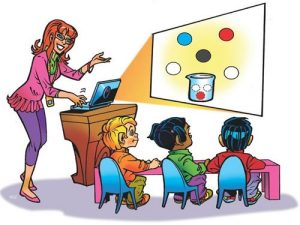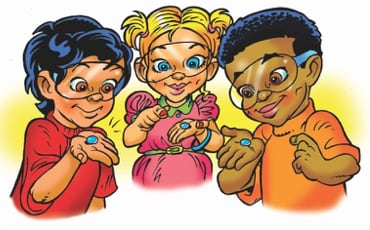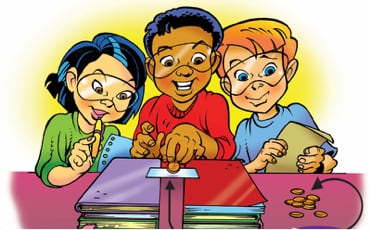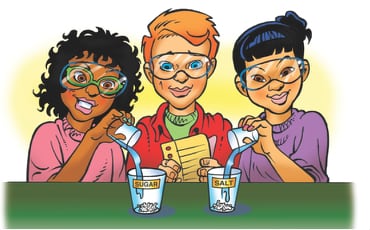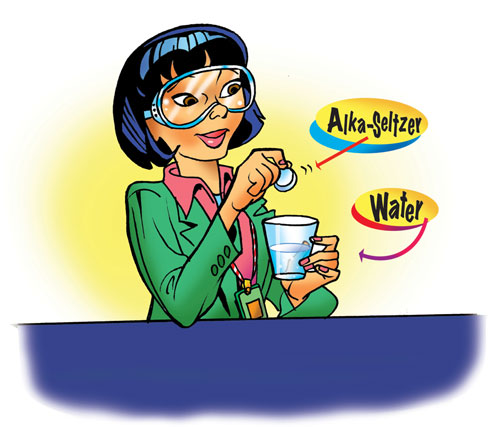Lesson Overview for Teachers
View the video below to see what you and your students will do in this lesson.
Downloadables:
Lesson Plan (PDF) | Teacher Background (PDF) | Connections to NGSS (PDF) | Molecule Card (PDF)
Objective
Students will be able to explain that Snap Cubes or other objects can be used as models of atoms. Students will also be able to explain that atoms can be rearranged to make different molecules.
Key Concepts
- Matter is made up of very small parts called atoms.
- Atoms can combine in different numbers and in different ways to make different molecules.
- Atoms and molecules make up all of the different substances, including solids, liquids, and gases that are all around us.
- Models can be used to represent atoms and these models can be rearranged to represent different molecules.
Summary
- Students see an animation showing that the things around them are made of atoms and molecules.
- Students use Snap Cubes to make models of atoms and molecules. They are given white, red, blue, and black cubes that represent hydrogen, oxygen, nitrogen, and carbon atoms respectively.
- Students are guided to take atoms apart, rearrange them, and put them together again in different ways to make six different molecules.
- Students also see a fun molecule-making game that they can try.
Evaluation
There is no student activity sheet for this lesson. After clicking on each molecule in the animation, you may want to circulate around the room to see how well students understand how to create models of the molecules using Snap Cubes.
Safety
This activity uses toys and is considered nonhazardous.
Materials for each group
10 snap cubes (4 white – hydrogen; 3 red – oxygen; 2 black – carbon; and 1 blue – nitrogen)
Teacher preparation:
You will need 2 sets of Snap Cubes
Snap cubes can be purchased at:
- hand2mind (ETA) http://www.hand2mind.com/item/snap-cubes-set-of-100/5486
- Amazon https://www.amazon.com/Learning-Resources-Mathlink-Cubes-Set/dp/B000URL296
- Lakeshore Learning http://lakeshorelearning.info/seo/p%7CRA529~~.jsp
They also go by the name Pop Cubes, Linking Cubes, and Mathlink Cubes.
Print out and laminate (optional) the two sheets containing a total of six Molecule Cards (PDF). Cut the sheets in thirds so that each molecule is on a third-sheet of paper. You will display these cards for students to see at different points in the lesson.
Give each student group a set of 10 snap cubes (4 white – hydrogen; 3 red – oxygen; 2 black – carbon; and 1 blue – nitrogen). If you don’t have enough of each color, each group can make its own color key for colors to represent hydrogen, oxygen, carbon, and nitrogen. You may want each group to create a color key they can refer to in order to remember the color that represents each atom. If you cannot get Snap Cubes, you can use colored Styrofoam balls or gumdrops with toothpicks.
ENGAGE
1. Remind students of the different substances they have worked with and explain that these substances are all made of atoms and molecules.
Remind students that the different materials they have looked at so far like wood, plastic, metal, and rubber are all made from tiny particles called atoms. Explain that different combinations of atoms make up different molecules. Atoms and molecules make up all the substances and objects in the world.
Tell students that the different colored Snap Cubes (or other items you are using) are models that stand for or represent different atoms. Let students know that each group should have 4 white, 3 red, 2 black, and 1 blue cube. The white ones stand for hydrogen, the red are oxygen, the black are carbon, and the blue is nitrogen.
Explain that scientists use models of atoms to see the different ways atoms can connect together to make molecules. Let students know that they will take atoms apart and put them together in new ways to make new molecules.
EXPLORE/EXPLAIN
2. Use an animation to show students a molecule and have them use their Snap Cubes to make a model of the molecule.
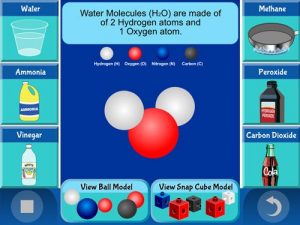
Show the Animation Using Snap Cubes to make Atoms and Molecules.
Water
Click on “Water” and tell students that plants, animals, and all life on Earth need water to survive.
Use the animation to show students a ball model of a water molecule (H2O) and post the water molecule card. Explain that a water molecule has two hydrogen atoms and one oxygen atom. Ask students to use Snap Cubes to make a water molecule. Then show students the animated Snap Cube model of a water molecule.
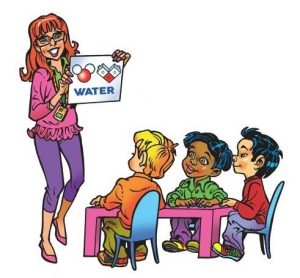
Carbon dioxide
Click on “Carbon dioxide” and tell students that carbon dioxide is the gas that animals and people breathe out. Plants need carbon dioxide to live. Carbon dioxide is also in the bubbles in soda pop.
Use the animation to show students a ball model of a carbon dioxide molecule (CO2) and post the carbon dioxide molecule card. Explain that a carbon dioxide molecule has 1 carbon atom and 2 oxygen atoms.
Ask students to use Snap Cubes to make a carbon dioxide molecule. Then show students the animated Snap Cube model of a carbon dioxide molecule.
Ammonia
Click on “Ammonia” and tell students that ammonia is in many cleaning liquids. You need to be careful with these kinds of cleaning solutions because they could hurt your skin and eyes.
Use the animation to show students a ball model of an ammonia molecule (NH3) and post the ammonia molecule card. Explain that a molecule of ammonia has 1 nitrogen atom and 3 hydrogen atoms.
Ask students to use Snap Cubes to make an ammonia molecule. Then show students the animated Snap Cube model of an ammonia molecule.
Methane
Click on “Methane” and tell students that methane is a gas that is used in gas stoves and for heating houses.
Use the animation to show students a ball model of a methane molecule (CH4) and post the methane molecule card. Explain that a molecule of methane has 1 carbon atom and 4 hydrogen atoms.
Ask students to use Snap Cubes to make a methane molecule. Then show students the animated Snap Cube model of a methane molecule.
Hydrogen peroxide
Click on “Hydrogen Peroxide” and tell students that hydrogen peroxide is used to kill germs and bacteria (disinfectant) and also to help cuts and burns heal.
Use the animation to show students a ball model of a hydrogen peroxide molecule (H2O2) and post the hydrogen peroxide molecule card. Explain that a molecule of hydrogen peroxide has 2 hydrogen atoms and 2 oxygen atoms.
Ask students to use the Snap Cubes to make a hydrogen peroxide molecule. Then show students the animated Snap Cube model of a hydrogen peroxide.
Vinegar
Click on “Vinegar” and tell students that most vinegars are made from grapes, corn, apples, or rice. Salad dressings, pickles, and many other foods have vinegar in them.
Use the animation to show students a ball model of an acetic acid (vinegar) molecule
(C2H4O2) and post the vinegar molecule card. Explain that an acetic acid molecule has 2 carbon atoms, 4 hydrogen atoms, and 2 oxygen atoms.
Ask students to use the Snap Cubes to make an acetic acid molecule. Then show students the animated Snap Cube model of vinegar.
EXTEND
3. Show and play a molecule-making game.
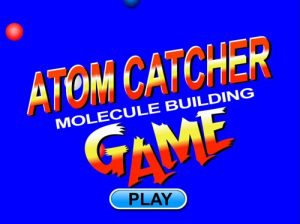
Show students the fun molecule-making game, Atom Catcher.
Explain that the object of the game is to make molecules out of four types of atoms: oxygen, hydrogen, carbon, and nitrogen. To make a molecule, you have to catch the correct type and the correct number of atoms to make a particular molecule. To score the most points, make as many molecules as you can in the time given. Show students how to play and if you want, give students the URL to try it at home.
